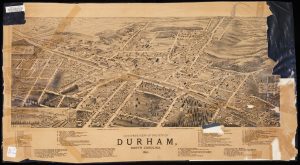Primary Source Set
Analyzing Maps
One of the ways people understand space and geography is through the creation of maps. A tool used to document locations, maps began to be used by more and more people after the invention of the printing press in the 15th century. This primary source set provides examples of North Carolina maps from three centuries to show how the state and its geographic documentation practices have evolved throughout history.
Time Period
18th-21st Centuries
Grade Level
3 – 6
Bird's Eye View of the City of Durham, N.C. (1891)
This map offers a bird’s eye view of Durham, North Carolina. It features city landmarks, street names, and prominent buildings throughout the city. When it was created in 1891, the city of Durham was only about 20 years old and most of the buildings in the city were built close to the railroad tracks.
Durham is known for its involvement in the tobacco industry. At the same time, an area in Durham became known as Black Wall Street because of the many Black-owned businesses on and around Parish Street. This map was created by the Burleigh Lithographing Establishment.
Contributed to DigitalNC by Durham County Library
Durham, North Carolina (Durham County)
Background
With the invention of the printing press in the 15th century, maps became a popular tool for documenting geography and understanding the world. The first maps of North Carolina during this time were by sailors using maps to record information about the North Carolina coast. Some of the earliest maps focus on British settlements around Cape Fear and the surrounding Native American communities. The maps you will see here are influenced by European cartography (or mapmaking) practices.
Maps have a lot of information. They are often flat representations of a place that use symbols to illustrate where things are located. Landscapes, roads, weather patterns, and animal habitats are a few examples of information you might find on a map. You may also find a key, a title, and a scale to help you better understand the map’s context and the meaning of certain symbols. If you think about all of the parts of a map together, it will be easier to understand. Knowing a map’s historical time period, its creator (a cartographer), and the people for whom the map was made can also help you understand a map.
Discussion Questions
What do you see in this map?
What area of North Carolina does it represent?
What type of map is this? What type of information does it feature (geographic, economic, topographic, etc.)?
Are there aspects of the map that clue you into its time period, social context, or purpose?
Does the map have any informational features (scale, annotations, key)? What kind of context do these features provide?
What type of materials or tools might have been used to create this map?
Can you find a current, digital map of the same location? What similarities and differences do you notice?
This primary source set was compiled by Sarah Costello Dwyer.
Updated January 2025
